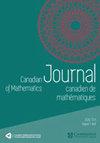阿贝尔泛函数
IF 0.7
3区 数学
Q3 MATHEMATICS
Canadian Journal of Mathematics-Journal Canadien De Mathematiques
Pub Date : 2022-10-26
DOI:10.4153/S0008414X22000578
引用次数: 1
摘要
摘要给定一个序列$\varrho =(r_n)_n\in[0,1)$趋近于$1$,我们考虑开放单位磁盘$\mathbb {D}$上由全纯函数f组成的Abel泛函数${\mathcal {U}}_A({\mathbb {D}}},\varrho)$的集合${\mathbb {T}}$对于包含在单位圆${\mathbb {T}}$中的任意紧集K,不同于${\mathbb {T}}$,集合$\{z\mapsto f(r_n \cdot)\vert _K:n\在\mathbb {n}\}$中在K上连续函数的空间${\mathcal {C}}(K)$中是稠密的,已知集合${\mathcal {U}}_A({\mathbb {D}},\varrho)$在$H(\mathbb {D})$中是残差。证明了它不与其他经典的全纯函数集重合。特别是,在包含方面,它甚至不能与在$0$处的泰勒多项式在${\mathcal {C}}(K)$中密集的全纯函数集相比,对于任何不同于${\mathbb {T}}$的紧集$K\子集{\mathbb {T}}$来说。此外,我们还证明了Abel泛函数在微分算子的作用下是不不变的。最后,阿贝尔泛函数可以看作是扩展算子序列$T_n:f\mapsto f(r_n \cdot)$作用于$H(\mathbb {D})$的一个泛向量。因此,我们研究了$(T_n)_n$的多普适性和(公)频繁普适性等动力学性质。所有的证明都是建设性的。本文章由计算机程序翻译,如有差异,请以英文原文为准。
Abel universal functions
Abstract Given a sequence
$\varrho =(r_n)_n\in [0,1)$
tending to
$1$
, we consider the set
${\mathcal {U}}_A({\mathbb {D}},\varrho )$
of Abel universal functions consisting of holomorphic functions f in the open unit disk
$\mathbb {D}$
such that for any compact set K included in the unit circle
${\mathbb {T}}$
, different from
${\mathbb {T}}$
, the set
$\{z\mapsto f(r_n \cdot )\vert _K:n\in \mathbb {N}\}$
is dense in the space
${\mathcal {C}}(K)$
of continuous functions on K. It is known that the set
${\mathcal {U}}_A({\mathbb {D}},\varrho )$
is residual in
$H(\mathbb {D})$
. We prove that it does not coincide with any other classical sets of universal holomorphic functions. In particular, it is not even comparable in terms of inclusion to the set of holomorphic functions whose Taylor polynomials at
$0$
are dense in
${\mathcal {C}}(K)$
for any compact set
$K\subset {\mathbb {T}}$
different from
${\mathbb {T}}$
. Moreover, we prove that the class of Abel universal functions is not invariant under the action of the differentiation operator. Finally, an Abel universal function can be viewed as a universal vector of the sequence of dilation operators
$T_n:f\mapsto f(r_n \cdot )$
acting on
$H(\mathbb {D})$
. Thus, we study the dynamical properties of
$(T_n)_n$
such as the multiuniversality and the (common) frequent universality. All the proofs are constructive.
求助全文
通过发布文献求助,成功后即可免费获取论文全文。
去求助
来源期刊
CiteScore
1.80
自引率
0.00%
发文量
58
审稿时长
4.5 months
期刊介绍:
The Canadian Journal of Mathematics (CJM) publishes original, high-quality research papers in all branches of mathematics. The Journal is a flagship publication of the Canadian Mathematical Society and has been published continuously since 1949. New research papers are published continuously online and collated into print issues six times each year.
To be submitted to the Journal, papers should be at least 18 pages long and may be written in English or in French. Shorter papers should be submitted to the Canadian Mathematical Bulletin.
Le Journal canadien de mathématiques (JCM) publie des articles de recherche innovants de grande qualité dans toutes les branches des mathématiques. Publication phare de la Société mathématique du Canada, il est publié en continu depuis 1949. En ligne, la revue propose constamment de nouveaux articles de recherche, puis les réunit dans des numéros imprimés six fois par année.
Les textes présentés au JCM doivent compter au moins 18 pages et être rédigés en anglais ou en français. C’est le Bulletin canadien de mathématiques qui reçoit les articles plus courts.

 求助内容:
求助内容: 应助结果提醒方式:
应助结果提醒方式:


